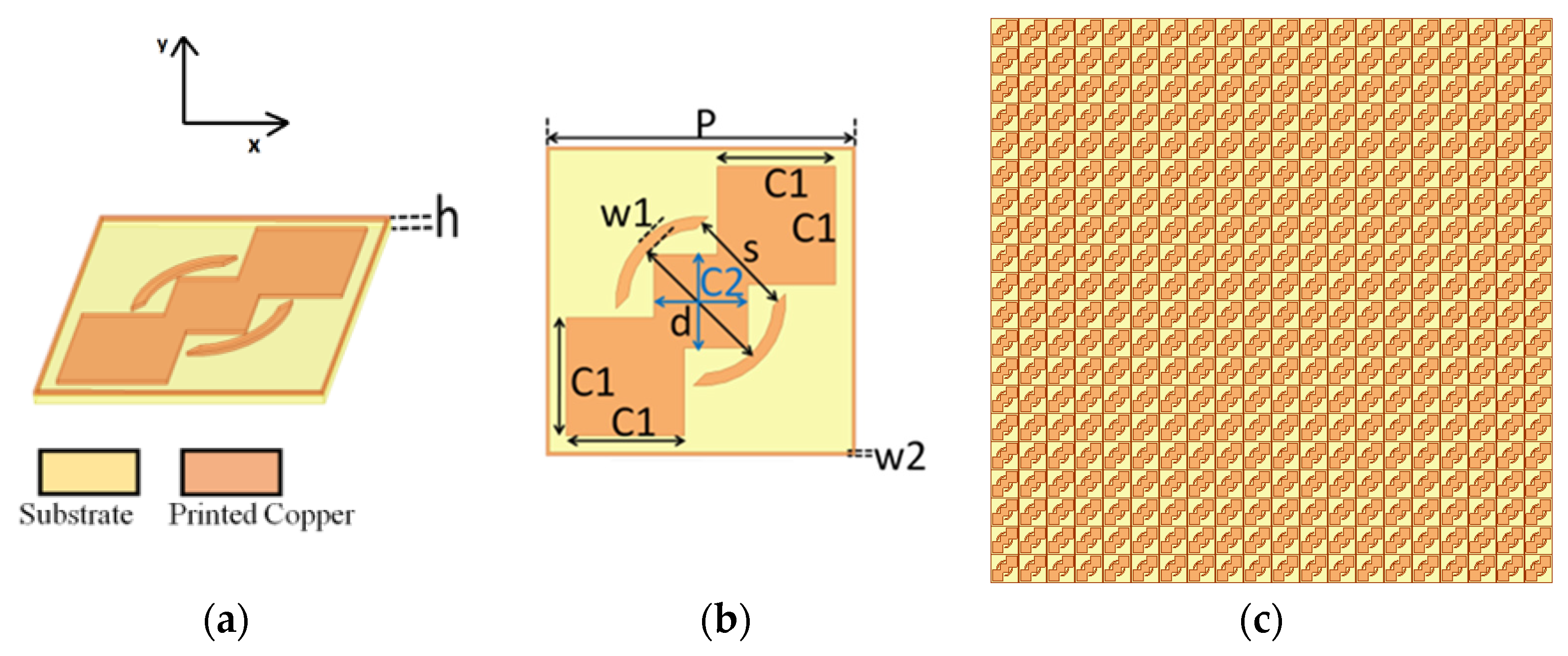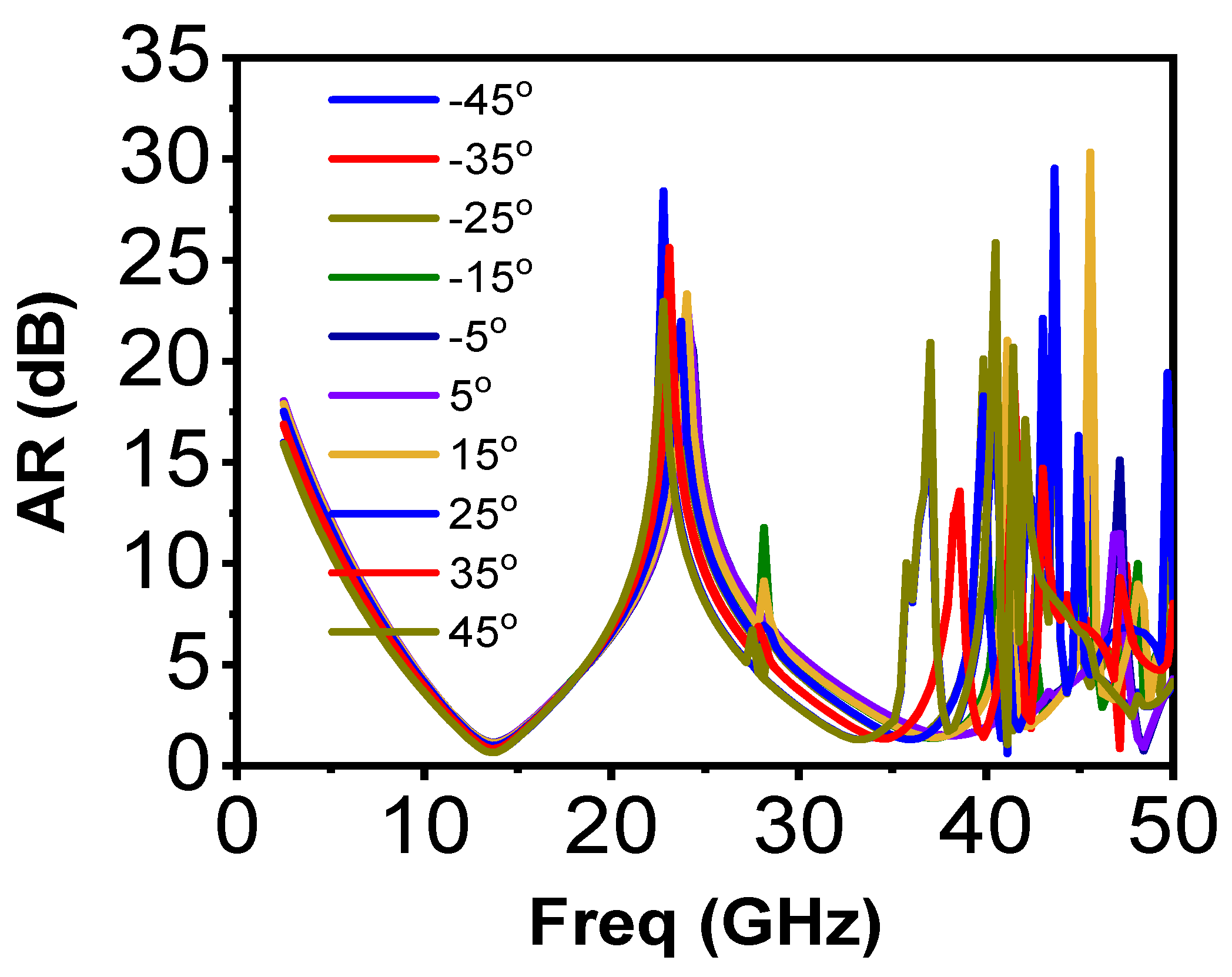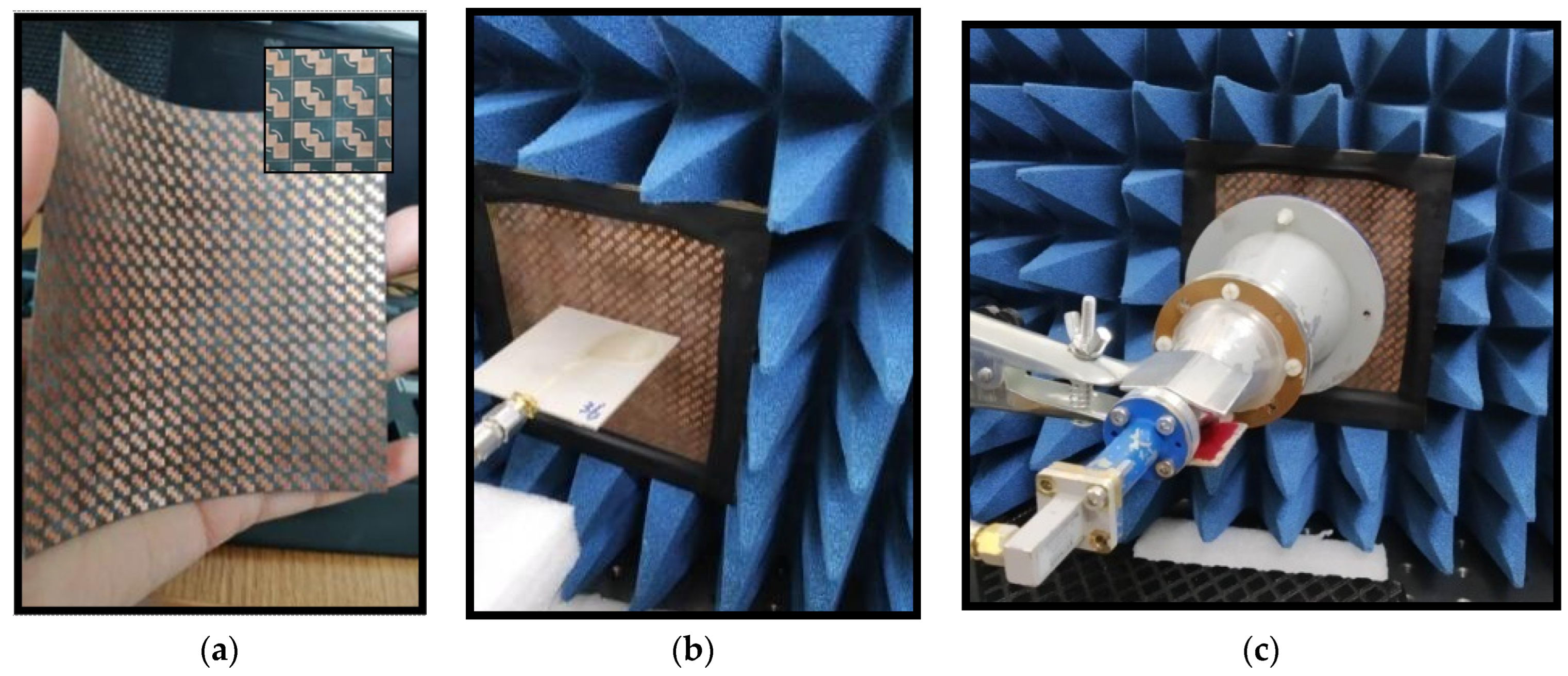Simple Design of Broadband Polarizers Using Transmissive Metasurfaces for Dual Band Ku/Ka Band Applications
Abstract
1. Introduction
2. Materials and Methods
- Ghosh et al. used a square ring as a basic building block for a periodic structure with wide operational bandwidth without performing any polarization conversion operations [32]. Therefore, the first element in the unit cell was a square ring with a width w2 in order to obtain wider operational bandwidth, as shown in Figure 1. The width of the ring controls the bandwidth, as well as the separation between the two bands of operation;
- Multiple square patches on a unit cell can cause multiple resonances, resulting in multiple bands of operation. Therefore, placing these patches along the diagonal can result in multiple operational bands [33]. In this way, three squares, C1, C2 and C1, were placed diagonally;
- According to the concept from [25,26,27], a split circular ring along the diagonal split can enable polarization conversion operations. Therefore, a diagonal split ring with internal diameter d and split opening S was selected as the third element in the unit cell. The width of the ring was w1. The effect of each parameter on the design of the polarizer is described in the following paragraph.
3. Simulation and Analysis
4. Discussion
5. Conclusions
Author Contributions
Funding
Institutional Review Board Statement
Informed Consent Statement
Data Availability Statement
Conflicts of Interest
References
- Kumar, S.; Lee, G.H.; Kim, D.H.; Choi, H.C.; Kim, K.W. Dual Circularly Polarized Planar Four-Port MIMO Antenna with Wide Axial-Ratio Bandwidth. Sensors 2020, 20, 5610. [Google Scholar] [CrossRef] [PubMed]
- Nalanagula, R.; Darimireddy, N.; Kumari, R.; Park, C.-W.; Reddy, R. Circularly Polarized Hybrid Dielectric Resonator Antennas: A Brief Review and Perspective Analysis. Sensors 2021, 21, 4100. [Google Scholar] [CrossRef] [PubMed]
- Mujahidin, I.; Kitagawa, A. CP Antenna with 2 × 4 Hybrid Coupler for Wireless Sensing and Hybrid RF Solar Energy Harvesting. Sensors 2021, 21, 7721. [Google Scholar] [CrossRef]
- Yunzheng, W.; Ning, J.; Lu, L.; Bosman, M.; Simpson, R.E. A scheme for simulating multi-level phase change photonics materials. NPJ Comput. Mater. 2021, 7, 183. [Google Scholar]
- Sheng, Y.; Liang, X.; Wang, W.; Jin, R.; Geng, J.; Bird, T.S.; Guo, Y.J. High-gain planar antenna arrays for mobile satellite communications [antenna applications corner]. IEEE Antennas Propag. Mag. 2012, 54, 256–268. [Google Scholar] [CrossRef]
- Constantine, A.B. Antenna Theory: Analysis and Design; John Wiley & Sons: Hoboken, NJ, USA, 2015. [Google Scholar]
- Stephen, D.T.; Pozar, D.M. Design of wideband circularly polarized aperture-coupled microstrip antennas. IEEE Trans. Antennas Propag. 1993, 41, 214–220. [Google Scholar]
- Wang, Y.Z.; Wang, P.L.; Lin, M. Design and experiment of X-Band circularly polarized antenna. Electron. Meas. Technol. 2010, 33, 26–29. [Google Scholar]
- Shang-Chi, J.; Xiong, X.; Hu, Y.-S.; Hu, Y.H.; Ma, G.; Peng, R.; Sun, C.; Wang, M. Controlling the polarization state of light with a dispersion-free metastructure. Phys. Rev. X 2014, 4, 021026. [Google Scholar]
- Xiang, X.; Jiang, S.; Hu, Y.S.; Hu, Y.; Wang, Z.; Peng, R.; Wang, M. Control the polarization state of light with symmetry-broken metallic metastructures. Ann. Phys. 2015, 358, 129–158. [Google Scholar] [CrossRef]
- Babar, K.; Chen, J.; Yin, Y.; Ren, J.; Ullah, S.; Ali, U. Design and experimental analysis of dual-band polarization converting metasurface. IEEE Antennas Wirel. Propag. Lett. 2021, 20, 1409–1413. [Google Scholar]
- Peng, F.; Guo, W.; Hu, W.; Zheng, Q.; Wen, X.; Chen, X.; Vandenbosch, G.A.E. A Transmissive Frequency-Reconfigurable Cross-Polarization Conversion Surface. IEEE Antennas Wirel. Propag. Lett. 2022, 21, 997–1001. [Google Scholar]
- Sofi, M.A.; Saurav, K.; Koul, S.K. Frequency-selective surface-based compact single substrate layer dual-band transmission-type linear-to-circular polarization converter. IEEE Trans. Microw. Theory Technol. 2020, 68, 4138–4149. [Google Scholar] [CrossRef]
- Heiman, A.; Tamas, R.D. Transforming Linear to Circular Polarization on Horn Antennas by Using Multiple-Layer Frequency Selective Surfaces. Sensors 2022, 22, 7838. [Google Scholar] [CrossRef]
- Adeline, M.R.; Karthikeyan, S.S.; Damodharan, P. Dual-Band Ultrathin Polarization Converter for S-Band Microwave Transmission. IEEE Microw. Wirel. Compon. Lett. 2022, 1–4. [Google Scholar] [CrossRef]
- Yannan, J.; Zhao, H.; Wang, L.; Wang, J.; Cao, W.; Wang, Y. Broadband linear-to-circular polarization converter based on phosphorene metamaterial. Opt. Mater. Express 2019, 9, 2088–2097. [Google Scholar]
- Yahong, L.; Luo, Y.; Liu, C.; Song, K.; Zhao, X. Linear polarization to left/right-handed circular polarization conversion using ultrathin planar chiral metamaterials. Appl. Phys. A 2017, 123, 571. [Google Scholar]
- Zhu, H.L.; Cheung, S.W.; Chung, K.L.; Yuk, T.I. Linear-to-circular polarization conversion using metasurface. IEEE Trans. Antennas Propag. 2013, 61, 4615–4623. [Google Scholar] [CrossRef]
- Pei, Y.; Dang, R.; Li, L. Dual-Linear-to-Circular Polarization Converter Based Polarization-Twisting Metasurface Antenna for Generating Dual Band Dual Circularly Polarized Radiation in Ku-band. IEEE Trans. Antennas Propag. 2022, 70, 9877–9881. [Google Scholar]
- Huang, X.; Yang, H.; Zhang, D.; Luo, Y. Ultrathin dual-band metasurface polarization converter. IEEE Trans. Antennas Propag. 2019, 67, 4636–4641. [Google Scholar] [CrossRef]
- Li, H.; Li, B.; Zhu, L. Wideband linear-to-circular polarizer based on orthogonally inserted slot-line structures. IEEE Antennas Wirel. Propag. Lett. 2019, 18, 1169–1173. [Google Scholar] [CrossRef]
- Abadi, S.M.; Hasan, A.M.; Behdad, N. Wideband linear-to-circular polarization converters based on miniaturized-element frequency selective surfaces. IEEE Trans. Antennas Propag. 2015, 64, 525–534. [Google Scholar] [CrossRef]
- Parinaz, N.; Matos, S.A.; Costa, J.R.; Fernandes, C.A.; Fonseca, N.J.G. Dual-band dual-linear-to-circular polarization converter in transmission mode application to K/Ka -band satellite communications. IEEE Trans. Antennas Propag. 2018, 66, 7128–7137. [Google Scholar]
- Qingyun, Z.; Ren, W.; Zhao, H.; Xue, Z.; Li, W. Dual-band transmission-type circular polariser based on frequency selective surfaces. IET Microw. Antennas Propag. 2019, 13, 216–222. [Google Scholar]
- Fahad, A.K.; Ruan, C.; Nazir, R.; Haq, T.; He, W. Dual-band ultrathin meta-array for polarization conversion in Ku/Ka-band with broadband transmission. IEEE Antennas Wirel. Propag. Lett. 2020, 19, 856–860. [Google Scholar] [CrossRef]
- Fahad, A.K.; Ruan, C.; Chen, K. Dual-wide-band dual polarization terahertz linear to circular polarization converters based on bi-layered transmissive metasurfaces. Electronics 2019, 8, 869. [Google Scholar] [CrossRef]
- Fahad, A.K.; Ruan, C.; Nazir, R.; Saleem, M.; Haq, T.; Ullah, S.; He, W. Ultra-thin metasheet for dual-wide-band linear to circular polarization conversion with wide-angle performance. IEEE Access 2020, 8, 163244–163254. [Google Scholar] [CrossRef]
- Bin, W.H.; Cheng, Y.J. Single-layer dual-band linear-to-circular polarization converter with wide axial ratio bandwidth and different polarization modes. IEEE Trans. Antennas Propag. 2019, 67, 4296–4301. [Google Scholar]
- Bowen, H.; Li, S.; Li, Z.; Huang, G.; Tian, J.; Cao, X. Asymmetric transmission for dual-circularly and linearly polarized waves based on a chiral metasurface. Opt. Express 2021, 29, 19643–19654. [Google Scholar]
- Yue, L.Z.; Li, S.J.; Han, B.W.; Huang, G.S.; Guo, Z.X.; Cao, X.Y. Quad-band transmissive metasurface with linear to dual-circular polarization conversion simultaneously. Adv. Theory Simul. 2021, 4, 2100117. [Google Scholar]
- Greco, F.; Arnieri, E. Dual-Frequency Linear-to-Circular Polarization Converter for Ka-Band Applications. Sensors 2022, 22, 2187. [Google Scholar] [CrossRef]
- Saptarshi, G.; Srivastava, K.V. An equivalent circuit model of FSS-based metamaterial absorber using coupled line theory. IEEE Antennas Wirel. Propag. Lett. 2014, 14, 511–514. [Google Scholar]
- Fahad, A.K.; Ruan, C.; Ali, S.A.K.M.; Nazir, R.; Haq, T.U.; Ullah, S.; He, W. Triple-wide-band ultra-thin metasheet for transmission polarization conversion. Sci. Rep. 2020, 10, 8810. [Google Scholar] [CrossRef] [PubMed]







| w2 | C1 | C2 | w1 | P | S | d | h |
|---|---|---|---|---|---|---|---|
| 0.05 MM | 1.9 mm | 1.5 mm | 0.2 mm | 5.1 mm | 1.8 mm | 2.3 mm | 0.127 mm |
| Ref | Frequency of Operations (GHz) | Operational Bandwidth (%) | No. of Layers | Operational Modes | Stability with Change in Angles |
|---|---|---|---|---|---|
| [21] | 19.6, 29.6 | 4, 2.7 | 3 | Same | - |
| [23] | 19.95, 29.75 | 2.5, 1.7 | 3 | Orth. | 30° |
| [24] | 7.6, 13 | 31.6, 13.8 | 4 | Same | ±25° |
| [25] | 17.8, 36.5 | 25, 16.4 | 2 | Orth. | - |
| [31] | 20.6, 29.2 | 12.5, 8.7 | 6 | Orth. | ±45°, ±30° |
| [28] | 18.5, 28.5 | 24, 11 | 2 | Orth. | - |
| This work | 13.9, 38.59 | 41, 23 | 1 | Orth. | ±45°, ±30° |
Publisher’s Note: MDPI stays neutral with regard to jurisdictional claims in published maps and institutional affiliations. |
© 2022 by the authors. Licensee MDPI, Basel, Switzerland. This article is an open access article distributed under the terms and conditions of the Creative Commons Attribution (CC BY) license (https://creativecommons.org/licenses/by/4.0/).
Share and Cite
Fahad, A.K.; Nazir, R.; Ruan, C. Simple Design of Broadband Polarizers Using Transmissive Metasurfaces for Dual Band Ku/Ka Band Applications. Sensors 2022, 22, 9152. https://doi.org/10.3390/s22239152
Fahad AK, Nazir R, Ruan C. Simple Design of Broadband Polarizers Using Transmissive Metasurfaces for Dual Band Ku/Ka Band Applications. Sensors. 2022; 22(23):9152. https://doi.org/10.3390/s22239152
Chicago/Turabian StyleFahad, Ayesha Kosar, Rabia Nazir, and Cunjun Ruan. 2022. "Simple Design of Broadband Polarizers Using Transmissive Metasurfaces for Dual Band Ku/Ka Band Applications" Sensors 22, no. 23: 9152. https://doi.org/10.3390/s22239152
APA StyleFahad, A. K., Nazir, R., & Ruan, C. (2022). Simple Design of Broadband Polarizers Using Transmissive Metasurfaces for Dual Band Ku/Ka Band Applications. Sensors, 22(23), 9152. https://doi.org/10.3390/s22239152







